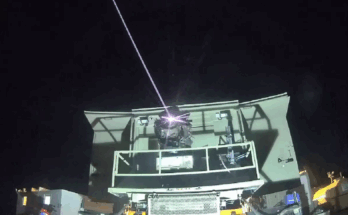
Although it might be too early to know exactly what effect the “Tariff Wars” will have on military technology in general, it is fairly certain that the “Drone Wars” will continue to be a major driver for one growing segment worldwide, namely, counter-drone systems.
While the U.S. effort to address the always-evolving threat of unmanned vehicles is defense-wide, one branch of the military has been making major strides of late. The U.S. Marine Corps, on April 14, announced plans to field dismounted counter-UAS capabilities across the entire Marine Air-Ground Task Force (MAGTF), an effort that will see widespread fielding of technologies to detect, track, identify, and defeat adversary UAS with both kinetic and non-kinetic means.
According to the USMC, these systems will be lightweight, easy-to-use, and easy-to-train, among other requirements. Plans call for the development and integration of unique C-UAS solutions, consisting of both mounted and dismounted capabilities.
One of these solutions has been revealed in a bit more detail. On March 13, Anduril won a $642 million, 10-year Program of Record by the USMC to deliver, install, and sustain Installation-C-UAS, enabling 24/7 autonomous operations. According to the company, the solution integrates multiple sensors and effectors and uses an open architecture design to enable rapid iteration and system upgrades.
For several years running, the DoD has been steadily supporting multiple C-UAS RDT&E efforts, as well as a far-reaching procurement and training program that will see hundreds of millions of dollars in annual spending through the rest of the decade. Currently, the RDT&E portion will see over $245.4 million allocated through FY29 for related program activities, while approximately $1.3 billion has been allocated for procurement throughout the same period.
With wildly divergent defense budget announcements almost becoming routine, recent events would appear to point toward ongoing support for C-UAS development in future budget moves. In March, Congress signed off on a request from the U.S. Army to move around FY24 funding in support of C-UAS capability for U.S. Central Command. The reprogramming approval enabled the service to move $20.3 million from the Hyrdra rocket program to procure four Containerized Weapon System-Advanced Precision Kill Weapon Systems (CWS-A).
Also in March, the Congressional Research Service released a report titled, “Department of Defense Counter Unmanned Aircraft Systems: Background and Issues for Congress.” According to the report, U.S. policymakers have expressed growing concern over the military threats posed by UAS, creating significant technical and operational challenges that must be addressed by the services.
Andrew Dardine is lead analyst for Forecast International's Defense Electronic Systems group. He is the primary author of Forecast International's Electronic Warfare Forecast and co-author of Electro-Optical Systems Forecast and C4I Forecast. Andrew is also a regular contributor to FI's Defense & Security Monitor blog, offering insights into developing technologies such as directed-energy and next-generation jamming systems. His analysis of such vital market areas as EO/IR systems and electronic countermeasures technology has been cited in Defense News, Aerospace Daily, and Bloomberg Businessweek, among other news media. He has also written about the electronic defense market for Aviation Week and the Journal of Electronic Defense.




